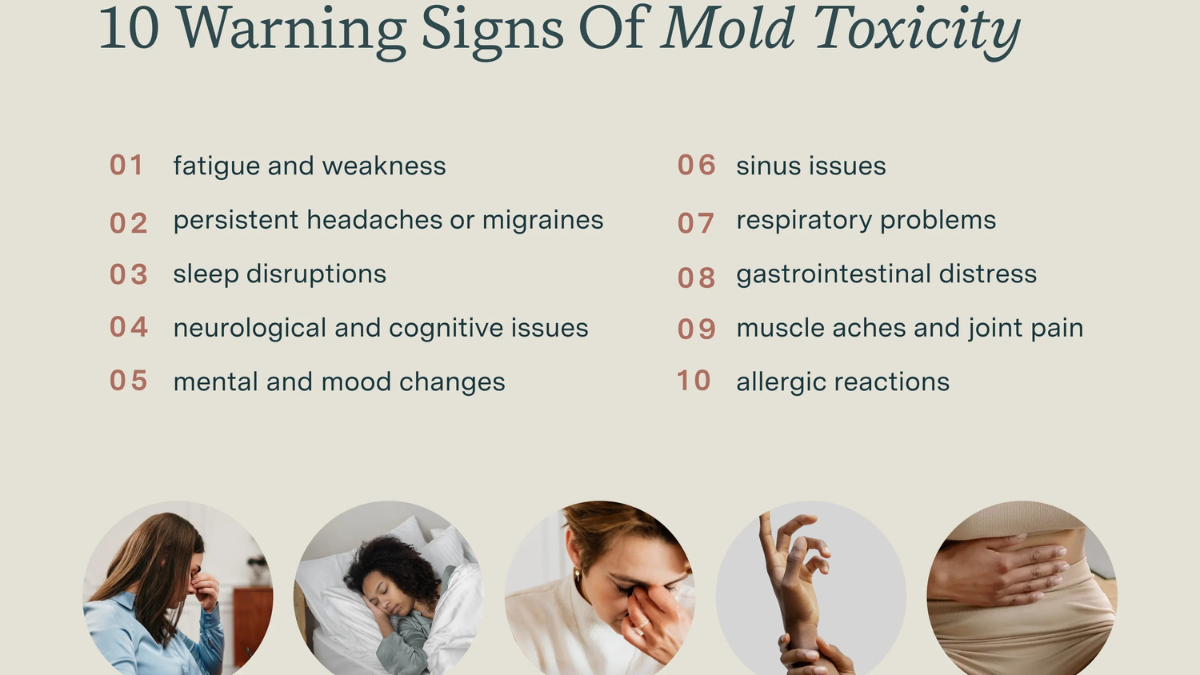HEALTH
10 Warning Signs of Mold Toxicity: A Comprehensive Guide

Mold toxicity, also known as mold illness or mold exposure, occurs when individuals are exposed to mold and its byproducts, leading to a range of adverse health effects. Mold can grow indoors and outdoors, thriving in damp and humid environments. Recognizing the 10 Warning Signs of Mold Toxicity is crucial for protecting your health and well-being.
Introduction
Mold toxicity refers to the harmful effects that mold exposure can have on individuals. Mold is a type of fungus that can grow indoors and outdoors, and when present in high concentrations, it can release toxins known as mycotoxins. These toxins can cause a variety of health problems, ranging from mild allergic reactions to severe respiratory and neurological issues. Identifying the warning signs of mold toxicity early is essential for mitigating its impact on health.
Visible Signs of Mold
One of the most obvious signs of mold toxicity is the presence of mold growth in visible areas. Mold can appear as black, green, or white spots on walls, ceilings, and other surfaces. Additionally, a musty odor in the environment is often indicative of mold growth. If you notice mold or a musty smell in your home or workplace, it’s essential to address the issue promptly to prevent further exposure.
Physical Symptoms
Mold toxicity can manifest in various physical symptoms, including respiratory issues such as coughing, wheezing, and shortness of breath. Individuals may also experience skin irritation, rashes, and allergic reactions when exposed to mold spores. These symptoms can range from mild to severe and may worsen over time if exposure continues.
Neurological Symptoms
In addition to physical symptoms, mold toxicity can affect neurological health. Individuals exposed to mold may experience headaches, migraines, and dizziness. Cognitive impairment, memory loss, and difficulty concentrating are also common neurological symptoms associated with mold toxicity. These symptoms can significantly impact daily functioning and quality of life.
Gastrointestinal Symptoms
Mold toxicity can also affect the gastrointestinal system, leading to digestive problems such as nausea, vomiting, diarrhea, and abdominal pain. These symptoms may occur shortly after exposure to mold or may develop over time with continued exposure. Individuals with pre-existing gastrointestinal conditions may be particularly susceptible to the effects of mold toxicity.
Fatigue and Weakness
Feeling tired and lethargic despite adequate rest is another common symptom of mold toxicity. Mold exposure can drain the body’s energy reserves, leading to fatigue, weakness, and malaise. Additionally, individuals may experience muscle weakness, joint pain, and general feelings of unwellness.
Sensitivity to Light and Sound
Some individuals with mold toxicity may experience increased sensitivity to light (photophobia) and sound (phonophobia). Bright lights and loud noises can exacerbate symptoms such as headaches, dizziness, and irritability. Managing environmental stimuli and reducing exposure to triggers can help alleviate these symptoms.
Changes in Mood
Mold toxicity can impact mood and emotional well-being, leading to symptoms such as anxiety, depression, and irritability. Mood swings, agitation, and feelings of hopelessness may also occur. These psychological symptoms can be particularly challenging to cope with and may require professional intervention.
Chronic Sinus Infections
Frequent sinus congestion, nasal congestion, and sinus infections are common among individuals exposed to mold. Mold spores can irritate the nasal passages and sinuses, leading to inflammation and infection. Persistent sinus pressure, headaches, and facial pain may indicate chronic sinus issues related to mold toxicity.
Worsening of Asthma
For individuals with asthma, mold exposure can exacerbate existing respiratory symptoms and lead to asthma attacks. Wheezing, coughing, chest tightness, and difficulty breathing may worsen in environments with high mold concentrations. Proper management of asthma and avoidance of mold exposure are essential for preventing complications.
Conclusion
Recognizing 10 Warning Signs of Mold Toxicity is crucial for protecting your health and well-being. If you experience any of the symptoms mentioned above, especially in conjunction with mold exposure, it’s essential to seek medical attention promptly. Additionally, taking steps to prevent mold growth in your home or workplace can help reduce the risk of mold-related health problems.
HEALTH
Mesothelioma: A Comprehensive Guide
Mesothelioma is a rare and aggressive form of cancer that primarily affects the lining of the lungs, abdomen, or heart. Awareness of this disease is crucial because early detection can significantly improve outcomes. This article will provide an in-depth look at mesothelioma, including its causes, symptoms, diagnosis, treatment options, and more.
What is Mesothelioma?
Mesothelioma is a type of cancer that develops in the mesothelium, a thin layer of tissue that covers most of your internal organs. The most common form is pleural mesothelioma, which affects the lining around the lungs. Other types include peritoneal mesothelioma (abdomen), pericardial mesothelioma (heart), and testicular mesothelioma (testicles).
Causes of Mesothelioma
Asbestos Exposure
The primary cause of mesothelioma is exposure to asbestos, a group of minerals composed of microscopic fibers. When asbestos fibers are inhaled or ingested, they can become lodged in the lining of the lungs, abdomen, or heart, causing inflammation and eventually leading to mesothelioma.
Other Potential Causes
While asbestos exposure is the main risk factor, other potential causes and risk factors include radiation exposure, certain genetic factors, and exposure to specific chemicals.
Symptoms
Early Symptoms
Early symptoms of mesothelioma can be vague and similar to those of other illnesses. They include:
1Shortness of breath
2Chest or abdominal pain
3Persistent cough
4Unexplained weight loss
5Advanced Symptoms
As the disease progresses, symptoms may become more severe and include:
1Severe chest or abdominal pain
2Difficulty swallowing
3Swelling of the face and arms
4Fatigue and weakness
5Diagnosis of Mesothelioma
6Initial Medical Evaluation
Diagnosing mesothelioma typically begins with a detailed medical history and physical examination. Doctors will ask about any history of asbestos exposure and perform a physical exam to check for any abnormalities.
Diagnostic Tests and Procedures
Several diagnostic tests can help confirm a mesothelioma diagnosis:
Imaging Tests:
X-rays, CT scans, and MRIs can help detect abnormalities.
Biopsies:
A tissue sample is taken and analyzed for cancer cells.
Blood Tests:
Certain biomarkers in the blood can indicate mesothelioma.
Stages
Stage 1
Cancer is localized to one area and has not spread.
Stage 2
Cancer has spread to nearby tissues or lymph nodes.
Stage 3
Cancer has spread further within the region and to additional lymph nodes.
Stage 4
Cancer has spread to distant organs and tissues.
Treatment
Surgery
Surgical options aim to remove as much of the cancer as possible and may include procedures like pleurectomy or extrapleural pneumonectomy.
Chemotherapy
Chemotherapy uses drugs to kill cancer cells and can be administered before or after surgery to shrink tumors or kill remaining cancer cells.
Radiation Therapy
Radiation therapy uses high-energy rays to target and kill cancer cells, often used in conjunction with surgery and chemotherapy.
Emerging Treatments
Emerging treatments like immunotherapy, targeted therapy, and gene therapy are being researched and may offer new hope for mesothelioma patients.
Prognosis and Survival Rates
Factors Affecting Prognosis
Prognosis depends on factors such as the stage of the disease at diagnosis, the patient’s overall health, and how well the cancer responds to treatment.
Survival Statistics
Survival rates for mesothelioma vary, with an average survival time ranging from 12 to 21 months. Early detection and treatment can improve these statistics.
Living with Mesothelioma
Coping Strategies
Living with mesothelioma can be challenging, but coping strategies such as maintaining a healthy lifestyle, seeking emotional support, and staying informed about the disease can help.
Support Systems
Support from family, friends, healthcare providers, and support groups is crucial in managing the physical and emotional aspects of the disease.
Mesothelioma and Legal Rights
Asbestos Exposure Lawsuits
Many people with mesothelioma are entitled to compensation through asbestos exposure lawsuits. These lawsuits hold companies accountable for exposing workers to asbestos.
Compensation Claims
Compensation can cover medical expenses, lost wages, and other related costs. Legal assistance can help navigate these claims.
Preventing Mesothelioma
Reducing Asbestos Exposure
The best way to prevent mesothelioma is to reduce asbestos exposure by following safety guidelines and regulations, especially in workplaces that handle asbestos.
Workplace Safety Measures
Employers should implement safety measures such as proper ventilation, protective equipment, and regular monitoring of asbestos levels to protect workers.
Mesothelioma Research and Advances
Recent Studies
Recent studies have focused on improving diagnostic methods, finding new treatments, and understanding the genetics of mesothelioma.
Future Directions in Research
Future research aims to develop more effective treatments, early detection methods, and potentially a cure for mesothelioma.
Support Resources for Mesothelioma Patients
Patient Advocacy Groups
Groups like the Mesothelioma Applied Research Foundation and the Asbestos Disease Awareness Organization offer support and resources to patients and families.
Financial Assistance Programs
Financial assistance programs can help cover treatment costs and other expenses associated with mesothelioma.
Mesothelioma Awareness and Education
Awareness Campaigns
Awareness campaigns aim to educate the public about the dangers of asbestos and the importance of early detection of mesothelioma.
Educational Resources
Educational resources, including websites, brochures, and seminars, provide valuable information about mesothelioma for patients, families, and healthcare providers.
Conclusion
Mesothelioma is a devastating disease, but understanding its causes, symptoms, and treatment options can help those affected manage it better. Early detection and comprehensive care are essential for improving outcomes. Continued research and awareness are crucial in the fight against this cancer.
FAQs
What is the main cause of mesothelioma?
The primary cause of mesothelioma is exposure to asbestos fibers, which can be inhaled or ingested, leading to inflammation and cancer development.
How is mesothelioma diagnosed?
Mesothelioma is diagnosed through a combination of medical history, physical exams, imaging tests, biopsies, and blood tests.
What are the treatment options for mesothelioma?
Treatment options include surgery, chemotherapy, radiation therapy, and emerging treatments like immunotherapy and gene therapy.
Can mesothelioma be prevented?
Mesothelioma can be prevented by reducing exposure to asbestos through safety measures and regulations in workplaces that handle asbestos.
What support resources are available for mesothelioma patients?
Support resources include patient advocacy groups, financial assistance programs, and educational resources to help patients and families manage the disease.
HEALTH
Dehydration in Summer: Everything You Need to Know

Summer is here, and while it’s the perfect time for beach trips, barbecues, and outdoor fun, it’s also the season when dehydration becomes a real concern. Let’s dive into why staying hydrated is crucial during these hot months and how you can prevent dehydration from putting a damper on your summer plans.
Summer brings warmth, sunshine, and outdoor adventures, but it also brings the risk of dehydration. As temperatures rise, our bodies lose fluids more rapidly, making it essential to understand dehydration and its implications. Let’s delve into everything you need to know about dehydration in summer.
Causes of Dehydration
Dehydration occurs when the body loses more fluids than it takes in. Several factors contribute to this imbalance, including inadequate water intake, excessive sweating, and high temperatures. During hot summer days, we tend to sweat more profusely, leading to significant fluid loss if not replenished adequately.
Symptoms of Dehydration
Recognizing the signs of dehydration is crucial for prompt intervention. Common symptoms include thirst, dry mouth, fatigue, dizziness, and dark urine. These indicators signal the body’s need for water and should not be ignored, especially during hot weather.
Effects of Dehydration on the Body
Dehydration can have detrimental effects on physical and cognitive function. It impairs physical performance, reduces concentration, and increases the risk of heat-related illnesses such as heat exhaustion and heatstroke. Staying hydrated is paramount for maintaining optimal health and well-being.
Prevention of Dehydration
Preventing dehydration involves simple yet effective measures. Increasing water intake, avoiding excessive alcohol and caffeine consumption, and dressing appropriately for the weather can help maintain hydration levels. It’s essential to listen to your body’s cues and hydrate accordingly.
Recognizing Dehydration in Different Age Groups
Different age groups may exhibit varying symptoms of dehydration. Infants and young children are particularly vulnerable due to their inability to communicate thirst effectively, while older adults may experience decreased thirst sensation. Understanding these nuances is vital for timely intervention.
Treatment
Treating involves rehydration with water or electrolyte solutions. In severe cases, medical attention may be necessary to restore fluid balance and prevent complications. It’s essential to address dehydration promptly to avoid further health issues.
The Importance & Physical Activity
Hydration plays a crucial role in physical activity, affecting performance and recovery. Athletes should implement hydration strategies tailored to their needs, such as consuming electrolyte-rich beverages and monitoring fluid intake during exercise. Proper hydration enhances athletic performance and reduces the risk of injuries.
Risks in Specific Populations
Certain populations are at higher risk of dehydration, including individuals with chronic illnesses, pregnant women, and those taking certain medications. These groups should take extra precautions to stay hydrated and seek medical advice if necessary.
The Role of Electrolytes
Electrolytes such as sodium, potassium, and magnesium play a vital role in hydration and fluid balance. Consuming electrolyte-rich foods and beverages can help replenish lost minerals and maintain optimal hydration levels, especially during periods of increased sweating.
Signs of Severe
Severe dehydration requires immediate medical attention and may present with symptoms such as sunken eyes, dry skin, rapid heartbeat, and confusion. Prompt intervention is essential to prevent complications and restore fluid balance.
Tips for Traveling
Traveling presents unique challenges to hydration, such as long flights and changing climates. It’s crucial to stay hydrated during travel by drinking water regularly and avoiding excessive alcohol and caffeine intake. Adjusting fluid intake based on environmental conditions can help prevent dehydration.
Myths and Facts About Hydration
There are many misconceptions surrounding hydration, such as the belief that only water can hydrate or that thirst is a reliable indicator of hydration status. Separating myths from facts is essential for making informed decisions about hydration and maintaining optimal health.
Incorporating Hydration into Daily Routine
Incorporating hydration into your daily routine is key to staying hydrated. Setting reminders to drink water, choosing hydrating snacks and meals, and prioritizing fluid intake throughout the day can help maintain optimal hydration levels and support overall well-being.
Conclusion
Dehydration in summer poses significant health risks, but with awareness and proactive measures, it can be prevented. By understanding the causes, symptoms, and effects of dehydration, as well as implementing strategies for prevention and treatment, you can stay hydrated and healthy all summer long.
FAQs:
How much water should I drink during hot weather?
The general recommendation is to drink at least eight glasses of water per day, but individual needs may vary based on factors such as activity level and climate.
Can I stay hydrated by drinking other beverages besides water?
While water is the best choice for hydration, other beverages such as herbal tea, coconut water, and diluted fruit juices can also contribute to fluid intake.
What are the signs of dehydration in infants and young children?
Signs of dehydration in infants and young children include dry mouth, crying without tears, sunken fontanelle (soft spot on the head), and decreased urine output.
HEALTH
Cotton Pollen and Viral Infections: Debunking the Myth

Have you ever heard someone say that cotton pollen can cause viral infections? It’s a common belief, but how true is it? In this article, we’ll dive into the world of cotton pollen, explore the science behind viral infections, and finally debunk this pervasive myth. Let’s get started!
What is Cotton Pollen?
Cotton pollen is the fine powder produced by the flowers of cotton plants. Like other pollen types, it’s crucial for plant reproduction. Each tiny grain of pollen carries the male genetic material needed for fertilizing the female part of the flower. This process is essential for the production of cotton bolls, which are harvested for their fibers.
How Cotton Pollen is Dispersed
like many other types of pollen, is typically spread by wind. This means it can travel significant distances from its source, potentially triggering allergic reactions in susceptible individuals. The dispersal pattern can be influenced by various factors such as wind speed, humidity, and geographical features.
Viral Infections and Their Causes
Common Viral Infections
Viral infections are caused by viruses, microscopic pathogens that invade living cells to reproduce. Common viral infections include the flu, the common cold, and more severe diseases like HIV and hepatitis. Viruses can infect various parts of the body, including the respiratory system, digestive tract, and skin.
How Viral Infections Spread
Viruses spread through various means, including direct contact with infected individuals, airborne transmission, contaminated surfaces, and bodily fluids. They rely on host organisms to reproduce and spread further. For example, the flu virus spreads primarily through droplets when an infected person coughs or sneezes.
The Myth of Cotton Pollen and Viral Infections
Origins of the Myth
The idea that cotton pollen can cause viral infections likely stems from misunderstandings about allergies and viruses. Because pollen can trigger respiratory symptoms similar to those of viral infections, it’s easy to see how the two could be confused. Additionally, during cotton harvesting seasons, people may experience heightened allergy symptoms, leading to the false association.
Scientific Studies on Cotton Pollen
Numerous scientific studies have investigated the effects of cotton pollen on health. None have found any evidence to support the claim that cotton pollen can cause viral infections. Instead, these studies highlight that pollen can trigger allergic reactions, which are entirely different from viral infections. For example, a study published in the Journal of Allergy and Clinical Immunology confirms that pollen is a significant allergen but does not link it to viral infections.
How Pollen Affects Health
Allergies Caused by Pollen
Many people are allergic to pollen, experiencing symptoms such as sneezing, itchy eyes, and runny noses. These symptoms are the body’s immune response to what it mistakenly identifies as a harmful substance.
Pollen and Respiratory Issues
In addition to allergies, high concentrations of pollen can exacerbate respiratory conditions like asthma. However, these issues are related to allergic reactions, not viral infections.
Distinguishing Allergies from Viral Infections
Symptoms of Allergies
Allergies typically cause symptoms such as sneezing, itchy or watery eyes, runny nose, and congestion. These symptoms can be seasonal and often worsen during times of high pollen count.
Symptoms of Viral Infections
Viral infections, on the other hand, often cause symptoms like fever, body aches, fatigue, and sometimes more severe respiratory symptoms. Unlike allergies, viral infections are usually accompanied by systemic symptoms affecting the whole body.
Prevention and Treatment
Preventing Pollen-Related Allergies
To prevent pollen-related allergies, keep windows closed during high pollen seasons, use air purifiers, and shower after spending time outdoors. Over-the-counter antihistamines can also help manage symptoms.
Treating Viral Infections
For viral infections, the best course of action is usually rest, hydration, and over-the-counter medications to alleviate symptoms. In some cases, antiviral drugs may be prescribed. It’s crucial to see a doctor if symptoms are severe or persist.
Conclusion
While cotton pollen can cause allergic reactions, there’s no scientific evidence to suggest it can cause viral infections. Understanding the difference between allergies and viral infections is key to addressing your symptoms effectively. Next time you hear someone say that can cause viral infections, you’ll know the facts and can help dispel the myth.
FAQs
Can cotton pollen cause any serious health issues?
Cotton pollen can cause allergies and exacerbate asthma, but it does not cause viral infections.
How can I reduce my exposure to cotton pollen?
Keep windows closed, use air purifiers, and avoid outdoor activities during peak pollen times.
What are the main differences between allergy and viral infection symptoms?
Allergy symptoms include sneezing, itchy eyes, and runny nose, while viral infections often cause fever, fatigue, and body aches.
Are there any treatments specifically for cotton pollen allergies?
Yes, antihistamines and nasal sprays can help manage allergy symptoms caused by cotton pollen.
Why do people believe cotton pollen can cause viral infections?
The belief likely stems from confusion between the symptoms of allergies and viral infections, as they can appear similar.
-

 LIFE STYLE9 months ago
LIFE STYLE9 months agoPurenudism: Embracing a Natural Lifestyle
-

 HEALTH8 months ago
HEALTH8 months agoEverything You Need To Know About Wellhealth: How to Build Muscle Tag
-

 APPS9 months ago
APPS9 months agoCapCut: Revolutionizing Video Editing for All
-

 PRODUCTS9 months ago
PRODUCTS9 months agoUnveiling the Magic of Wow Hair Products: A Comprehensive Guide
-

 PRODUCTS9 months ago
PRODUCTS9 months agoArtificial Lenses: Enhancing Vision and Quality of Life
-

 BRANDS8 months ago
BRANDS8 months agoStepping Up Your Style Game: The Ultimate Guide to Mary Jane Heels
-

 BRANDS9 months ago
BRANDS9 months agoCroc Straightener: Revolutionizing Your Hair Styling Routine
-

 FASHION6 months ago
FASHION6 months agoTail Frock : A Comprehensive Guide
